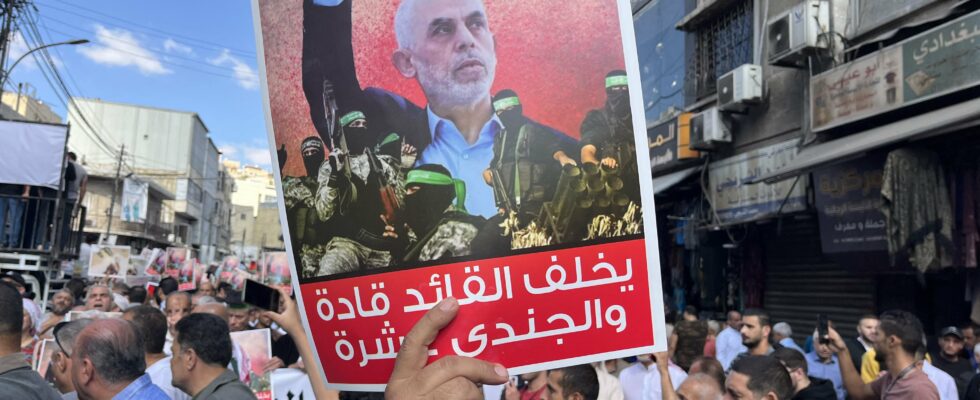Considered the architect of the October 7 massacre, his name appeared at the top of the kill list Israeli personalities to be killed. After a year of tracking, the Jewish state announced on October 17 the death of Yahya Sinouar, the leader of Hamas, during an operation in Rafah, in the south of the Gaza Strip. Two months after the assassination of his predecessor, Ismaïl Haniyeh, in an Israeli strike in Tehran, this elimination constitutes a new earthquake for the terrorist group, already decimated by months of fighting against the IDF forces in the Palestinian enclave.
“This is a bitter setback for Hamas,” summarizes Hugh Lovatt, Middle East specialist at the European Council on Foreign Relations. “This will have a major impact on the internal dynamics of the movement, but also on its strategy in the months future.”
Although Israeli Prime Minister Benjamin Netanyahu announced a few hours later that the death of Yahya Sinouar marked “the beginning of the end” of the war in Gaza, the movement affirmed the next day, Friday, October 18, that it could “not be eliminated” despite the death of its leaders.
Weakened militarily
Despite this undeniable success of the Israeli forces, the disappearance of Hamas is still far from being achieved. “Its hold on the Gaza Strip remains major,” continues Hugh Lovatt. “The movement has other potential leaders, such as Khalil al-Hayya, the vice-president of the political bureau.” Based in Qatar, this 62-year-old senior official, who in recent months has become one of the most visible figures in the political branch of the organization, said this Friday on Al-Jazeera that the death of his leader “will only strengthen” the Islamist movement. He is, moreover, not the only possible successor. Yahya Sinouar’s brother, Mohamed, one of the commanders of the military branch, could take the helm of the organization. And the name of Khaled Mechaal, founding member of the group and former president of the political bureau between 1997 and 2017, is also mentioned.
The fact remains that a little less than a year after the start of the operation launched by Israeli forces on October 27, 2023 in the Gaza Strip, the terrorist group appears more weakened than ever on a military level. “Today Hamas only has residual capabilities,” explains General Nicolas Richoux, former commander of the 7th Armored Brigade. If before October 7 it had a real army, a well-established hierarchy, and stocks of equipment and ammunition, all these elements have been very depleted.”
In addition to the consecutive deaths of Ismaïl Haniyeh and Yahya Sinouar, the rest of the Hamas staff was also decimated. On August 1, Israel claimed responsibility for the death of Mohammed Deïf, the head of its armed wing, in a strike that occurred two weeks earlier near Khan Younes, or that of Saleh al-Arouri, the movement’s number two, on August 2. January during a bombing in the southern suburbs of Beirut. The terrorist organization’s fighting forces also paid a heavy price. In August, an IDF spokesperson estimated that more than 17,000 Hamas fighters had been eliminated, out of an estimated 25,000 to 30,000 in the Gaza Strip.
“The organization can rise from its ashes”
Militarily on the mat, the group nevertheless retains a significant capacity for nuisance. Taking advantage of its many tunnels still operational and the tortuous, ambush-prone urban environment of the Palestinian enclave, the movement is still able to continue its guerrilla war against Israeli forces – and inflict increasing costs on them as his operation continues.
Despite the massacre in its ranks, the armed wing of Hamas did not wait to reiterate its desire to continue the fight. “Our jihad will not stop until the liberation of Palestine, the expulsion of the last Zionist and the restoration of all our legitimate rights,” declared the Ezzedine al-Qassam Brigades in a statement published on October 18. “Hamas will need time to reestablish a credible and structured force,” says General Richoux. “But even if this process could take between 5 and 10 years, the organization can rise from its ashes as long as its ideas persist.”
There is also the question of Israeli hostages – 97 are still in Gaza, 34 of whom were declared dead by the army. The day after the death of its leader, Hamas affirmed this Friday that they would not be released until the Jewish state puts an end to its operation. As an echo of the remarks made the day before by the chief of staff of the Israeli army, General Herzi Halevi, who had assured that the war “would not stop” before the capture of all the perpetrators of the attack and the return of “all the hostages”. “Even weakened, Hamas continues to be the most powerful movement in Gaza,” points out Hugh Lovatt. “Its ideology still permeates society, and in the absence of a political solution, the elimination of Sinouar will not be enough to defeat it. “
.
